Avascular Necrosis of the Hip: Symptoms, Causes and Exercises
- Best Asics Shoes for Flat Feet - October 25, 2024
- Best Running Shoes for Flat Feet - October 22, 2024
- Posterior Tibial Tendonitis - October 21, 2024
Avascular necrosis of the hip can also be termed osteonecrosis or ischemic necrosis of the femoral head. The bone structure weakness and the integrity of the structure can be lost. This leads to progressive secondary arthritis and can result in the collapse of the bone. This is caused by abnormal microcirculation and leads to cell death (necrosis).
Hip necrosis is a rare condition reported in 2 out of 100,000 people in the UK (Lamb et al, 2019) and up to 6 per 100,000 in the USA (Mujoomdar et al, 2012). It is more common in men, typically between 25 and 44 years, and less common in women, occurring at an older age, between 55 to 75. Hip avascular necrosis is one of the common reasons for total hip replacement surgery.
Causes
Risk factors for avascular necrosis of the hip include trauma, lifestyle factors, family history, sex, health, and medication. Men are at higher risk, and there is a hereditary link. People with conditions like lupus, sickle cell anaemia, and Gaucher disease have a higher risk of osteonecrosis.
Trauma is the cause of many cases of avascular necrosis of the hip, usually following a fall onto the hip. Health factors that can contribute include cholesterol levels, blood clotting issues, blood circulation issues, and immunosuppression, such as being HIV positive.
Some medications, such as chemotherapy and steroids, can also increase risk. Lifestyle factors such as being overweight or obese, smoking, abuse of alcohol, and living in an urban area all increase the risk of idiopathic or spontaneous necrosis.
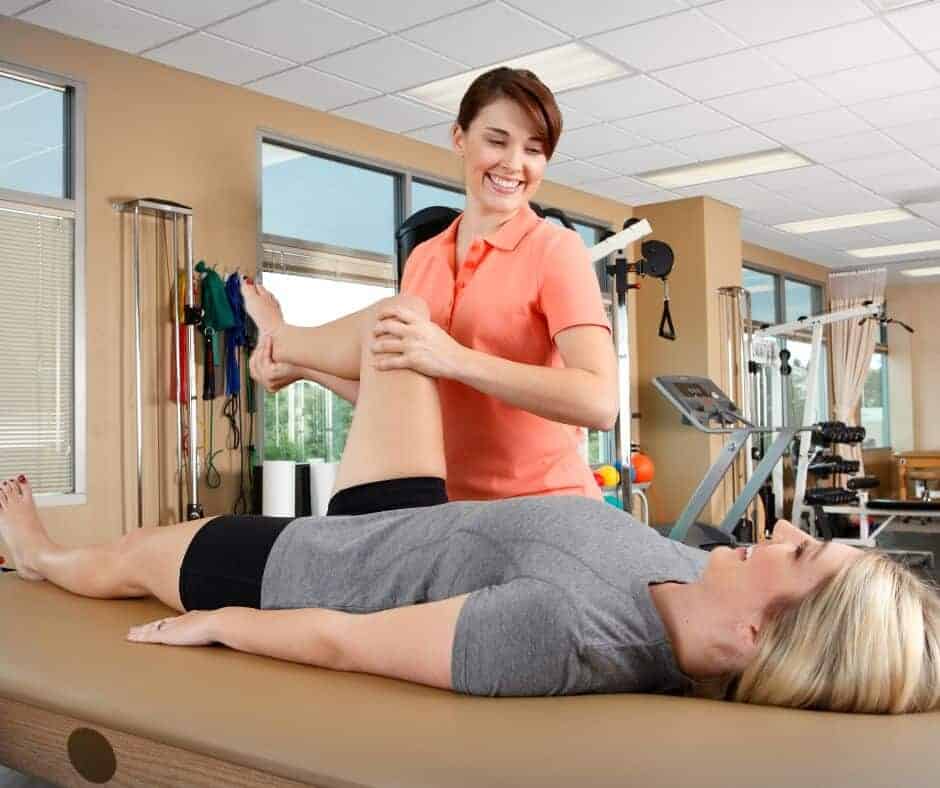
Symptoms
The most common symptom of hip avascular necrosis is pain, often felt in the groin or buttock. This is usually described as an ache or throbbing pain. Movement of the hip joint and weight-bearing through the hip joint will worsen symptoms. Typically pain is low in the early stages of the condition and worsens as it progresses.
As the hip avascular necrosis progresses, stiffness of the hip will become apparent and a loss of range of movement of the hip joint, initially due to pain, will occur.
In the later stages, a restriction of the range of movement may be caused by a change in the shape of the bone as its structural integrity collapses. It is unusual to see any swelling or bruising.
Diagnosis
Diagnosis of avascular necrosis of the hip is done by an experienced medical professional such as a medical doctor or physical therapist. There is no specific or unique test for avascular necrosis. A physical examination will look for a pattern of pain that matches this condition as well as any stiffness or reduced range of movement in the joint.
MRI imaging is the best diagnostic tool for the diagnosis of avascular necrosis of the hip. Unfortunately, it is often wrongly diagnosed as non-specific or mechanical hip pain, such as osteoarthritis. An X-ray can provide a false negative in the early stages of this condition.

Stages of Avascular Necrosis Hip
Stage 1
Typically asymptomatic.
Radiography with X-ray may show a normal hip, while an MRI may show minor osteopenia, oedema or dead bone.
Stage 2
Minor symptoms of pain are usually present.
Radiography may still look normal on X-ray, but an MRI can show sclerosis, osteopenia, or subchondral cysts.
Stage 3
Symptomatic of pain, joint stiffness and reduced range of motion.
Now x-ray and MRI will show pathology in the form of a crescent sign, a sign of bone collapse.
Stage 4
More painful and worse restriction of joint range of motion.
X-ray and MRI show cartilage damage osteoarthritis, and further collapse of subchondral bone.
Stage 5
Pain and severe dysfunction of the hip joint.
Both hip surfaces are affected and visible on x-ray and MRI.
Does Hip Replacement Cure Avascular Necrosis?
In the later stages of avascular necrosis, there may be no other option than surgery. A total hip replacement will replace the affected tissue with a prosthesis. This will, in effect, cure the condition and provide a functioning hip joint. However, a total hip replacement does have its restrictions, and certain precautions must be taken.
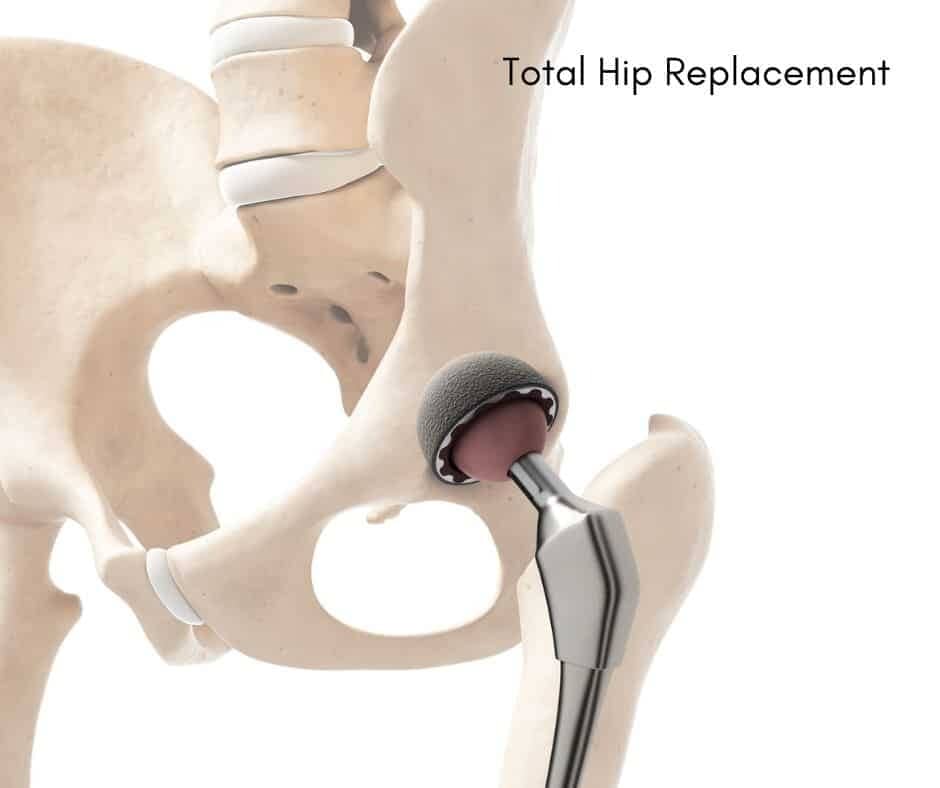
Avascular Necrosis of Hip Treatment
Avascular necrosis of the hip can be treated with medication, physical therapy and surgery. Different stages of this condition will need different treatments, and the health and physical conditioning of the individual will also affect treatment choice.
Medications
- Nonsteroidal anti-inflammatory drugs (NSAIDs), such as ibuprofen, Advil, or naproxen, can reduce pain. If necessary stronger options may be offered on prescription from your doctor.
- Osteoporosis drugs can sometimes be used with the aim of slowing down the disease.
- Cholesterol-lowering drugs lower blood levels of cholesterol and fat and can reduce the risk of blockages in the blood vessels that can lead to avascular necrosis.
- Medications that open blood vessels aim to improve the circulation reaching the bone.
- Blood thinners reduce the risk of blood clots in the vessels feeding the bone, which can lead to avascular necrosis.
Surgery
For most cases, around 80% of avascular necrosis hip treatment will be with surgery. Surgery is most often a total hip replacement, as this provides the most reliable positive outcome. But there are other surgical options that can be considered. Core decompression can be used in less severe cases.
Bone graft, osteotomy, and regenerative medicine treatment are options, but more research is needed to understand their efficacy and which patient can benefit most from which procedure.
Physical Therapy
Physical therapy for avascular necrosis of hip treatment can help with pain management and relief, joint mobility and strength. Physical therapy can be a helpful treatment for avascular necrosis of the hip, without surgery in the early stages of this condition.
It is often also advised to aid preparation for surgery and rehabilitation after surgery for more advanced cases. Strengthening exercises can help with the stability of the joint and the efficiency of movement, which can improve walking gait.
Exercises for Avascular Necrosis of the Hip
The best exercises include strengthening and mobility exercises for the hip joint. A strengthening programme should include glute, hamstring, adductor and hip flexor muscle exercises. Core exercises can also help with stability at the hip and pelvis and are useful to include. A strengthening exercise programme should be done two to three times per week.
Hip Abduction
Lie on your side with a resistance band tied around your ankles. Roll forward so that your upper buttock is on top. Keeping your upper leg straight, start from inline with your body and take your leg up and backwards. This movement should come from your hip joint, not your back, so you should feel the muscles of your buttocks working, these are your gluteal muscles.
Perform 12-15 repetitions for 3 sets, with a 1-2 minute break between.
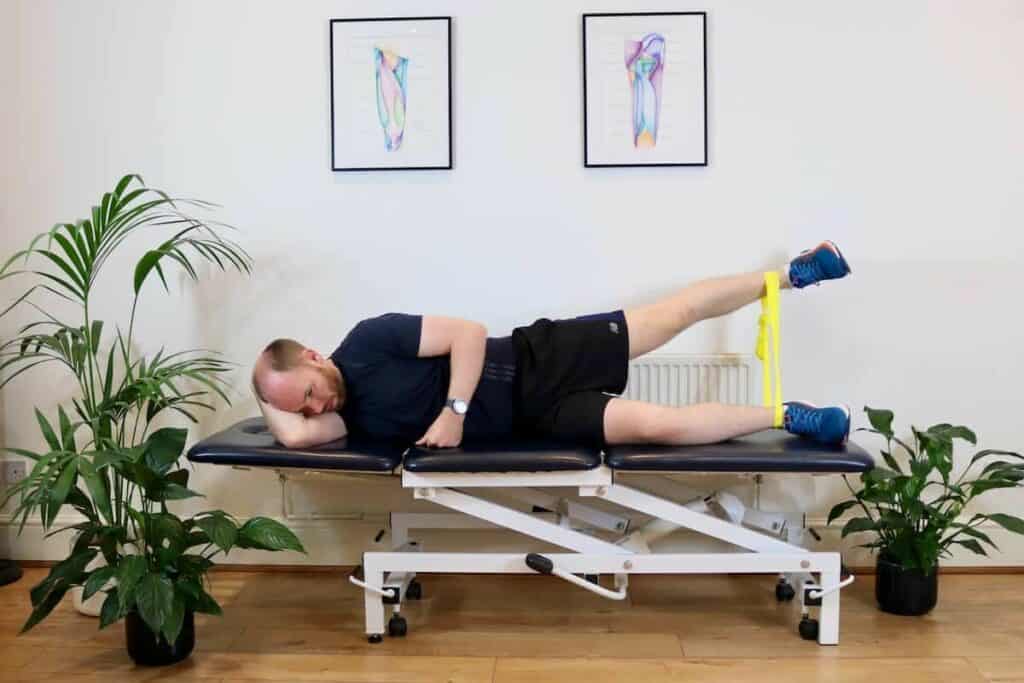
Glute Bridge
Lie on your back with a resistance band tied around your thighs, just above your knees. Your feet should be hip-width apart, and your knees should be bent to about 90º or slightly less so that your feet are not too close. Lift your pelvis up while keeping outward pressure on the band.
You should feel the muscles of your buttocks and the back of your thighs working. If you don’t feel the back of your thighs working, your feet should be further away.
Perform 12-15 repetitions for 3 sets, with a 1-2 minute break between.
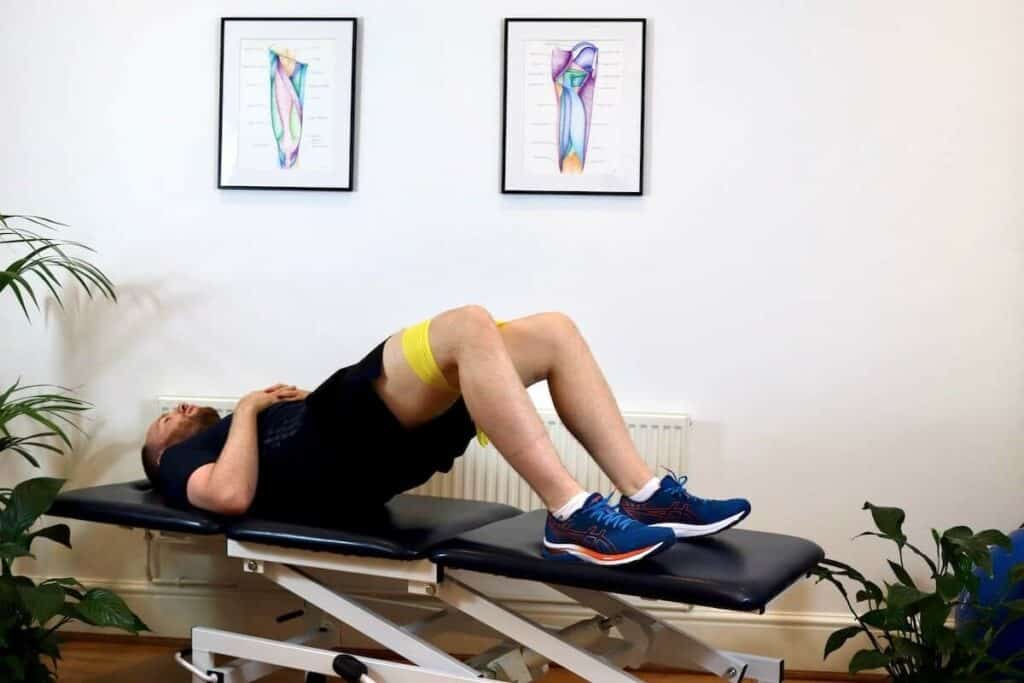
Hip Adduction
Stand with a resistance band tied around one ankle and something sturdy to your side. Maintain balance on one leg and start with your other leg out to the side, pulling the band inwards towards you. You should feel the muscle along the inside of your thigh working, these are your adductors.
Perform 12-15 repetitions for 3 sets, with a 1-2 minute break between.
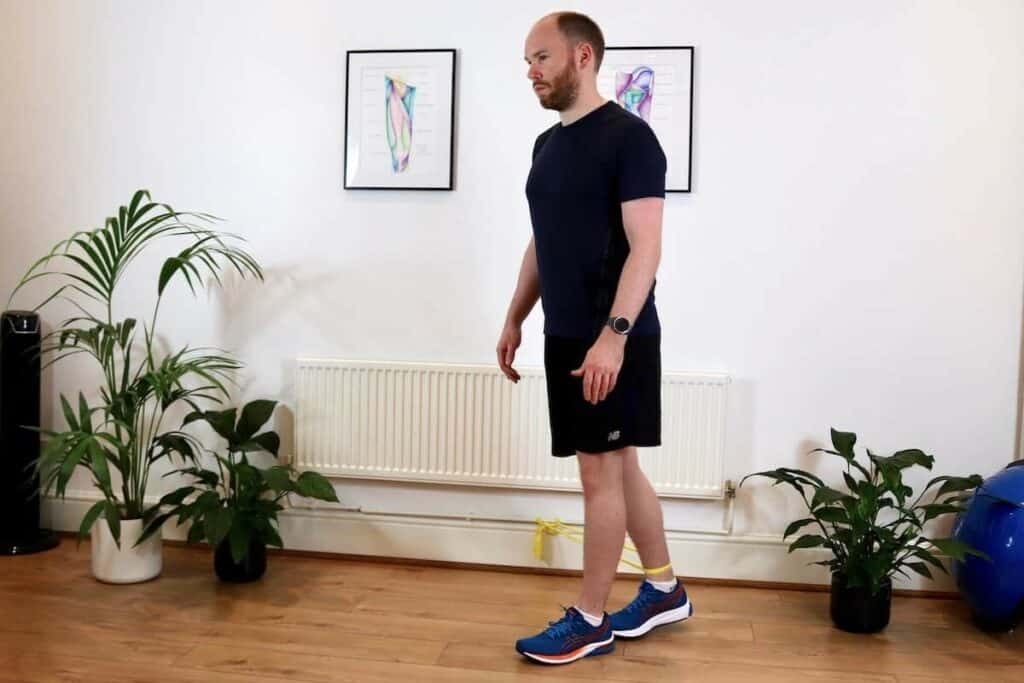
Hip Flexion
Stand with a resistance band tied around one foot/ankle and stand with your other foot on the other end of the band. Maintain balance on one leg and a straight upper body posture.
Raise the other leg against the resistance band, with a bent knee up until you reach a 90º angle at your hip. You should feel the muscle at the front of your hip working; these are your hip flexors.
Perform 12-15 repetitions for 3 sets, with a 1-2 minute break between.
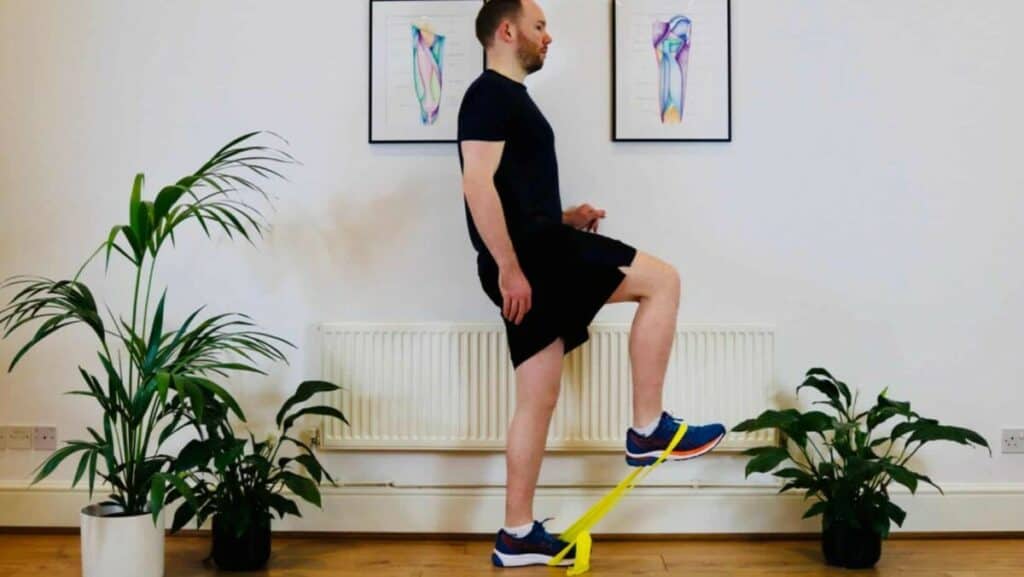
Core Strengthening
Lie on your back with your knees bent and your feet on the floor. Flatten your back against the floor using your abdominal muscles, and raise your arms towards the ceiling. Raise one foot off the floor at a time into a tabletop position (right leg in the picture), keeping your back flat against the floor and abdominal muscles engaged and flat.
If you can keep your tummy flat in this position, you can straighten one leg away, then return and repeat on the opposite side.
Perform 6-8 repetitions on each side for 3 sets, with a 1-2 minute break between.
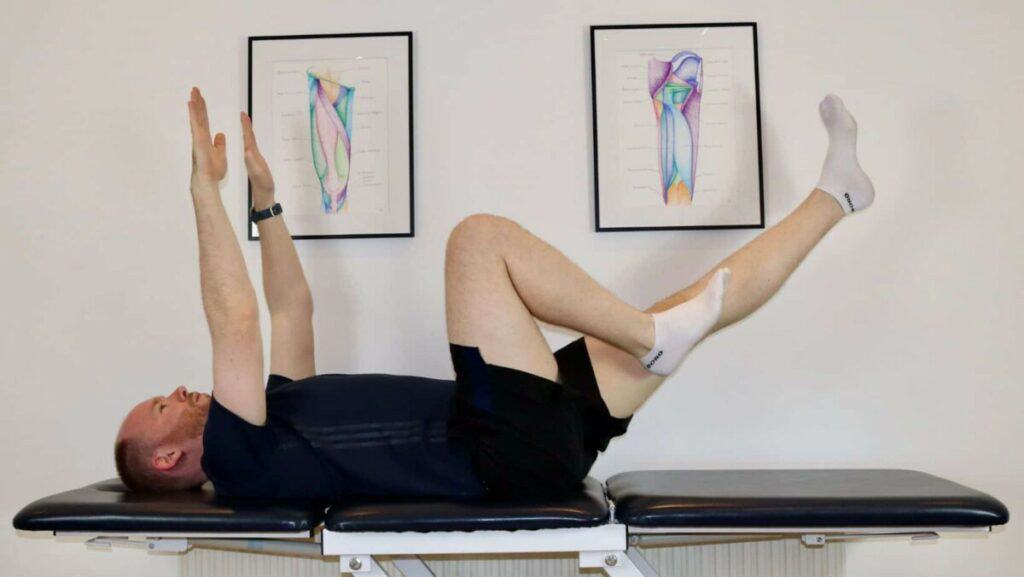
Related Articles:
Meralgia Paresthetica – Hip Pain Diagram – FAI Exercises
_______________________________________
We are specialists in Physiotherapy, with our clinic in Fulham, South West London.
We offer Online Appointments for £60 and Face-to-Face appointments for £85 in our clinics.
